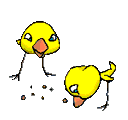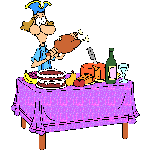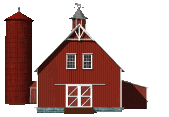RAISING TURKEYS
BREEDER FARM ----> HATCHERY ----> TURKEY FARM
- Breeder Farm: The hens (female turkeys) lay the eggs.
The eggs are collected daily and stored before being shipped to
the hatchery.

- Hatchery: The eggs are cleaned and placed in incubators.
An incubator keeps the temperature and humidity just right.
In 28 days the poults (baby turkeys) hatch.
They are kept warm and comfortable until the time is right to move them.

- Turkey Farm: Poults are shipped to a turkey farm within 24 hours
of being removed from their incubator. The hens (females) and the toms (males)
live in separate areas. The young birds must be kept warm and
given special feed They are carefully watched
for the first few weeks till the down (soft fuzzy feathers) is replaced by the
outer feathers.
Turkeys are raised in special climate-controlled barns that protect
them from bad weather, disease and predators (enemies).
The floor of the barn is covered with a soft bed of straw or wood chips.
The birds move about the barn freely and are given plenty with food and water.
Turkeys eat a mixture (corn, wheat,soybeans) that IS ground up to look like granola.
The turkey "droppings" and the straw and wood chips from the barns are composted and
used as fertilizer for gardens and lawns.
PROCESSING THE TURKEYS
TURKEY FARM ----> PROCESSING PLANT ----> STORE
- Hens are ready to be processed when they are about 14 weeks old.
Toms are not processed till they reach the correct weight (18 to 24 weeks).
- Transportation: When birds are ready for market they are loaded into special
shipping crates and transported in trucks to the processing plant.
The trucks are covered with tarps to protect the birds from the
outside weather. After each flock of birds is raised, the barn is totally
cleaned and disinfected. This helps prevent the
spread of disease from one flock to another.
- The processing plant: The turkeys
are plucked, eviscerated (insides are removed) and chilled.
The turkey is inspected for health and graded.
Some turkeys are cut into parts while whole turkeys are bagged.
The meat is either frozen or kept refrigerated till shipment to stores.
- At the supermarket:
Turkey is sold whole (fresh, frozen), in parts (wings,
breasts, thighs, legs) or as ground turkey. Turkey is also available in
processed products (smoked, cutlets, rolls, burgers, wieners, bacon)

TURKEY IS GOOD FOR YOU
-
Turkey is low in fat and high in protein.
The white meat has fewer calories and less fat than dark meat.
- A 15 pound turkey (6.8 kilograms) usually has about 70 percent white meat
and 30 percent dark meat.
-
June is National Turkey Loverís Month. There are recipes for many
different ways to prepare turkey as well as ideas for leftover turkey.
-
The five most popular ways to serve leftover turkey is as a sandwich, stew or soup,
salad, casserole and stir-fry.

|



